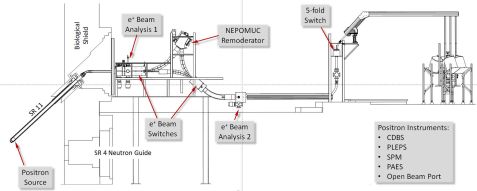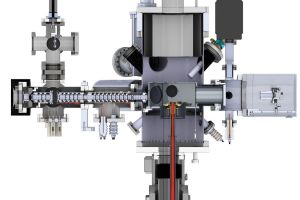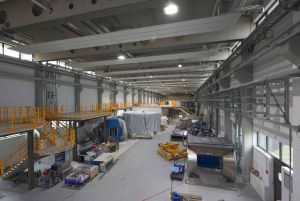MLZ is a cooperation between:
 > Technische Universität München
> Technische Universität München > Helmholtz-Zentrum Hereon
> Helmholtz-Zentrum Hereon
 > Forschungszentrum Jülich
> Forschungszentrum Jülich
MLZ is a member of:
 > LENS
> LENS > ERF-AISBL
> ERF-AISBL
MLZ on social media:

MLZ (eng)
Lichtenbergstr.1
85748 Garching
NEPOMUC
Neutron induced positron source Munich
NEPOMUC provides a high-intensity, low-energy positron beam for applications in solid state and surface physics as well as for fundamental research in nuclear and atomic physics. The intensity amounts to > 109 moderated positrons per second at a beam energy of E = 1 keV.
At NEPOMUC, the positrons are generated by pair production from the absorption of high-energy prompt gamma rays after thermal neutron capture in cadmium [1]. A cadmium cap is mounted inside the tip of the inclined beam tube SR-11. The released high-energy gamma radiation is converted into positron-electron pairs in a structure of platinum foils, which is mounted inside the cadmium cap. Positive high voltage is applied to extract the moderated positrons. The positron beam is magnetically guided in a solenoid field of typically 5 – 7 mT.
At NEPOMUC, 80 % 113Cd enriched cadmium is used as a neutron-gamma-converter, which has a projected lifetime of 25 years of reactor operation [2] and an intensity of > 109 moderated positrons per second has been achieved [3].
The positron beam facility
The remoderation device of NEPOMUC [4] enhances the brightness of the positron beam and hence enables positron experiments which are highly resolved in space or/and in the time domain. The remoderator is based on the positron cooling in a W(110) single crystal and the reemission of thermalised positrons into the vacuum with discrete energy. For most of the measurements, the brightness-enhanced positron beam is used. However, there are also experiments which do not depend on a high phase space density but need the full intensity of the primary beam. Therefore, the primary beam can also be used unaltered via two beam switches, e.g., for experiments at the open beam port.
By the central, fivefold beam switch, the positron beam is delivered to one of the five experiment beamlines. At one port, the positron annihilation-induced Auger electron spectrometer (PAES) has been used for surface experiments, and a positron diffractometer (TRHEPD) was recently tested there. These instruments will be available in the Neutron Guide Hall East in the future. At another beam port, a scanning positron microscope (SPM) is being set up.
There are currently three instruments in routine operation:- Pulsed low-energy positron system (PLEPS)
- Coincidence Doppler Broadening Spectrometer (CDBS)
- Open beam port for additional experiments (currently a magnetic trap to generate a pair of plasma).
[1] Hugenschmidt, C. et al., NIM-A, 593(3), 616 (2008).
[2] Hugenschmidt, C. et al., New J. Phys., 14(5), 055027 (2012).
[3] Hugenschmidt, C. et al., J. Phys.: Conf. Ser., 505(1), 012029 (2014).
[4] Piochacz, C. et al., Appl. Surf. Sci., 255(1), 98 (2008).
Examples and applications of positrons can be found on the website Physics with Positrons.
- The Ps ion – A leptonic three body system
The negative positronium ion Ps– is a bound system consisting of two electrons and a positron.
- The positron – an ideal microprobe for defects
A positron implanted into a solid thermalises rapidly and then diffuses in the bulk until it annihilates with valence or core electrons. In a defect-free lattice, this diffusion process lasts around 100 ps; during this period, the positron typically covers a distance of 100 nm in a random walk.
Positrons have numerously proven their enormous sensitivity for the non-destructive detection of defects. By experiments performed at NEPOMUC, it could be shown that also metallic precipitates can be characterised with highest sensitivity.
- E = 1 keV
- Intensity: > 109 moderated positrons per second
- Diameter of beam spot: ≈ 9 mm (FWHM) in 7 mT beam guiding field
- E = 10 … 200 eV
- Intensity: 5 × 107 remoderated positrons per second
- Diameter of beam spot: 1.85 mm (FWHM) in ≈ 4 mT beam guiding field
Instrument scientists
Prof. Dr. Christoph Hugenschmidt
Phone: +49 (0)89 289-14609
E-mail: christoph.hugenschmidt@frm2.tum.de
Dr. Francesco Guatieri
Phone: +49 (0)89 289-54713
E-mail: francesco.guatieri@frm2.tum.de
NEPOMUC
Phone: +49 (0)89 289-14774
TUM Research Group
Operated by


Funding

News
Publications
Find the latest publications regarding NEPOMUC in our publication database iMPULSE:
Citation templates for users
In all publications based on experiments on this instrument, you must provide some acknowledgements. To make your work easier, we have prepared all the necessary templates for you on this page.
MLZ is a cooperation between:
 > Technische Universität München
> Technische Universität München > Helmholtz-Zentrum Hereon
> Helmholtz-Zentrum Hereon
 > Forschungszentrum Jülich
> Forschungszentrum Jülich
MLZ is a member of:
 > LENS
> LENS > ERF-AISBL
> ERF-AISBL
MLZ on social media:







